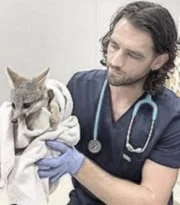Hello fellow wildlife enthusiasts! In this month’s issue of the Swampin Newsletter I’d like to discuss lead toxicity in wild critters. Wildlife medicine is such a fascinating field and we are continuously learning more and more about the wild critters we share the environment with. Every now and then, major shifts occur and in recent times it’s the frequency of occurrence of lead found in wildlife. I’m sure we all have heard about lead poisoning in some form or another, but its’ prevalence in different species and the origins of toxicity are things we’re just beginning to understand.
An estimated 20 million animals, including over 130 different species, are believed to die each year from lead poisoning. Ingestion of lead pellets or projectile fragments are the most common source of lead poisoning for wild birds. Less commonly, birds can experience toxicity following the consumption of other lead objects such as fishing sinkers, lead bullets or their fragments, mine waste, and paint chips. Raptors are most often exposed to lead as a result of feeding on prey containing lead, while waterfowl incidentally ingest objects containing lead while foraging in fresh waterways.
Led sinkers
So what is Lead? Lead (Pb) is a naturally occurring metal that has no known biological purpose- meaning any presence of lead within the body is abnormal and of concern. Due to it’s low cost and physical properties, it is a favorable metal used in the production of items such as batteries, paints, gasoline, galvanized wire, and of course ammunition and fishing sinkers.
It’s important to note here that in order for an animal to experience lead toxicity, the object must be ingested and not just present in the muscle or skin of the animal. The acidic environment of the gizzard or stomach causes the objects to erode, and the lead is absorbed into the blood stream and transported to tissues throughout the body. Without the acidic erosion within the gizzard or stomach, lead cannot be absorbed and distributed throughout the body.
We’re used to hearing about lead toxicity in raptors and waterfowl from ingesting spent lead pellets and fishing sinkers, but what we’ve seen in the last decade is an increase in the occurrence of toxic lead levels in wild mammalian species, notably in opossums, squirrels, and rabbits; and very rarely are these toxicities secondary to ingesting lead pellets or fishing sinkers. So how exactly are these species being exposed to lead?
Simply put, lead is now in our environment and wild spaces. For many decades it was used in paint, gasoline, and pesticides and as these substances leach into the soil, plants can absorb lead, and thus act as sources of potential lead toxicity. This means the opossum or rabbit in the yard could be ingesting lead from plants around the garage or driveway. This is especially true in older urban settings where lead was used extensively in city development for decades.
Lead toxicity is a chronic disease that overtime can cause significant damage to multiple organ systems. Clinical signs of toxicity vary depending on the species, the amount of circulating lead, and the chronicity of exposure. Typical signs include loss of appetite, generalized weakness, and inappropriate mentation. With lead test kits becoming more readily available and affordable, wildlife centers around the world are able to test for lead in any patient exhibiting signs consistent with lead. And this has significantly increased our greater understanding of which species are profoundly affected.
Lead toxicity can be diagnosed by testing whole blood lead levels. When an animal’s blood is tested for lead it takes a mere 120 seconds to get a result, with most in-house lead test kits. Full body radiographs should be performed to assess for the presence of metal in the gastrointestinal tract since removing the source of lead exposure is necessary for treatment. Note: the absence of metallic objects within the GI system does not rule out lead toxicity, especially when clinical signs are present. Animals with detectable levels of lead should be re-evaluated with multiple tests over the course of treatment since lead levels ebb and flow as lead leaches out of bones and fat where it is stored.
An animal can have a negative lead test one week and next week test positive again. Once an animal has two or three negative tests it’s generally considered treated. The duration of treatment can last up to months.
The fundamental treatment for lead toxicity is chelation therapy. Chelation therapy is the process of binding or “grabbing” heavy metals distributed throughout the body for eventual excretion via urine. Calcium (Ca) EDTA and succimer are both effective chelating agents in the treatment of lead toxicity and if there is a source of exposure present within the GI tract of the animal (lead shot, fishing tackle, etc), physical removal of the object is absolutely necessary for a positive outcome!
Unfortunately, lead toxicity in wildlife is something we’ll be dealing with for many years to come. There has just been so much lead deposited in our environment over the past several decades. But i’m very hopeful. With new and easier ways of detection, treatments that have shown great success, and more people willing to care for wild critters in distress, we are more prepared than ever to do what’s right for animals in need.
As stewards to the natural world, each of us has the capacity to care for what really benefits wildlife. And what benefits wildlife benefits us all!
Andrew Y. Kushnir DVM



